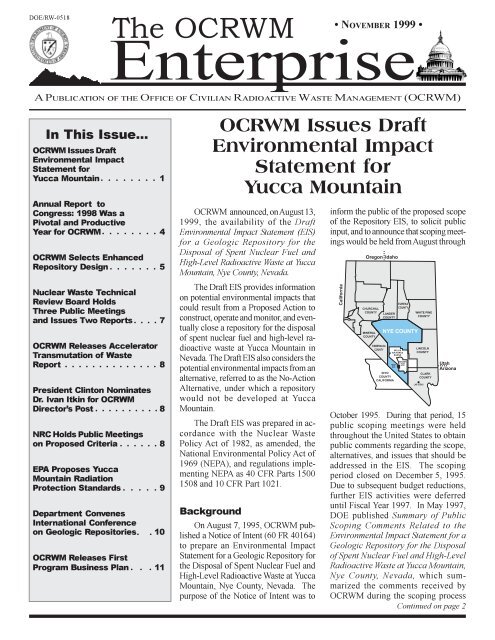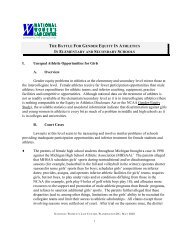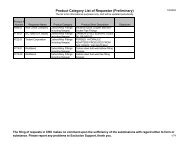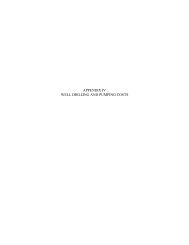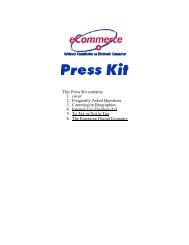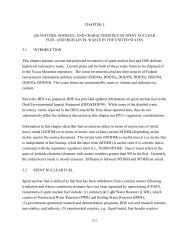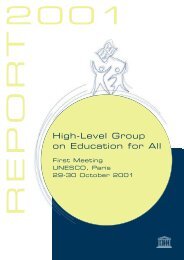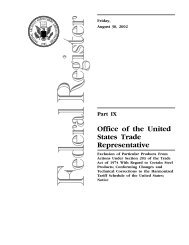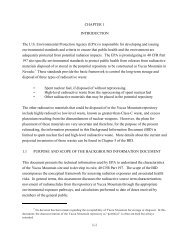The OCRWM Enterprise - November 1999
The OCRWM Enterprise - November 1999
The OCRWM Enterprise - November 1999
You also want an ePaper? Increase the reach of your titles
YUMPU automatically turns print PDFs into web optimized ePapers that Google loves.
DOE/RW-0518<br />
<strong>The</strong> <strong>OCRWM</strong><br />
<strong>The</strong> <strong>OCRWM</strong> <strong>Enterprise</strong> • <strong>November</strong> <strong>1999</strong> • Page 1<br />
• NOVEMBER <strong>1999</strong> •<br />
<strong>Enterprise</strong><br />
A PUBLICATION OF THE OFFICE OF CIVILIAN RADIOACTIVE WASTE MANAGEMENT (<strong>OCRWM</strong>)<br />
In This Issue...<br />
<strong>OCRWM</strong> Issues Draft<br />
Environmental Impact<br />
Statement for<br />
○ ○ ○ ○ ○ ○ ○ ○<br />
Yucca Mountain 1<br />
Annual Report to<br />
Congress: 1998 Was a<br />
Pivotal and Productive<br />
○ ○ ○ ○ ○ ○ ○ ○<br />
Year for <strong>OCRWM</strong> 4<br />
<strong>OCRWM</strong> Selects Enhanced<br />
Repository Design<br />
○ ○ ○ ○ ○ ○ ○<br />
5<br />
Nuclear Waste Technical<br />
Review Board Holds<br />
Three Public Meetings<br />
and Issues Two Reports ○ ○ ○ ○ 7<br />
<strong>OCRWM</strong> Releases Accelerator<br />
Transmutation of Waste<br />
Report<br />
○ ○ ○ ○ ○ ○ ○ ○ ○ ○ ○ ○ ○ ○<br />
8<br />
President Clinton Nominates<br />
Dr. Ivan Itkin for <strong>OCRWM</strong><br />
○ ○ ○ ○ ○ ○ ○ ○ ○ ○<br />
Director’s Post 8<br />
NRC Holds Public Meetings<br />
on Proposed Criteria<br />
○ ○ ○ ○ ○ ○<br />
8<br />
EPA Proposes Yucca<br />
Mountain Radiation<br />
Protection Standards<br />
○ ○ ○ ○ ○<br />
9<br />
Department Convenes<br />
International Conference<br />
on Geologic Repositories ○<br />
○ 10<br />
<strong>OCRWM</strong> Releases First<br />
Program Business Plan<br />
○ ○ ○<br />
11<br />
<strong>OCRWM</strong> Issues Draft<br />
Environmental Impact<br />
Statement for<br />
Yucca Mountain<br />
<strong>OCRWM</strong> announced, on August 13,<br />
<strong>1999</strong>, the availability of the Draft<br />
Environmental Impact Statement (EIS)<br />
for a Geologic Repository for the<br />
Disposal of Spent Nuclear Fuel and<br />
High-Level Radioactive Waste at Yucca<br />
Mountain, Nye County, Nevada.<br />
<strong>The</strong> Draft EIS provides information<br />
on potential environmental impacts that<br />
could result from a Proposed Action to<br />
construct, operate and monitor, and eventually<br />
close a repository for the disposal<br />
of spent nuclear fuel and high-level radioactive<br />
waste at Yucca Mountain in<br />
Nevada. <strong>The</strong> Draft EIS also considers the<br />
potential environmental impacts from an<br />
alternative, referred to as the No-Action<br />
Alternative, under which a repository<br />
would not be developed at Yucca<br />
Mountain.<br />
<strong>The</strong> Draft EIS was prepared in accordance<br />
with the Nuclear Waste<br />
Policy Act of 1982, as amended, the<br />
National Environmental Policy Act of<br />
1969 (NEPA), and regulations implementing<br />
NEPA as 40 CFR Parts 1500<br />
1508 and 10 CFR Part 1021.<br />
Background<br />
On August 7, 1995, <strong>OCRWM</strong> published<br />
a Notice of Intent (60 FR 40164)<br />
to prepare an Environmental Impact<br />
Statement for a Geologic Repository for<br />
the Disposal of Spent Nuclear Fuel and<br />
High-Level Radioactive Waste at Yucca<br />
Mountain, Nye County, Nevada. <strong>The</strong><br />
purpose of the Notice of Intent was to<br />
inform the public of the proposed scope<br />
of the Repository EIS, to solicit public<br />
input, and to announce that scoping meetings<br />
would be held from August through<br />
October 1995. During that period, 15<br />
public scoping meetings were held<br />
throughout the United States to obtain<br />
public comments regarding the scope,<br />
alternatives, and issues that should be<br />
addressed in the EIS. <strong>The</strong> scoping<br />
period closed on December 5, 1995.<br />
Due to subsequent budget reductions,<br />
further EIS activities were deferred<br />
until Fiscal Year 1997. In May 1997,<br />
DOE published Summary of Public<br />
Scoping Comments Related to the<br />
Environmental Impact Statement for a<br />
Geologic Repository for the Disposal<br />
of Spent Nuclear Fuel and High-Level<br />
Radioactive Waste at Yucca Mountain,<br />
Nye County, Nevada, which summarized<br />
the comments received by<br />
<strong>OCRWM</strong> during the scoping process<br />
Continued on page 2
<strong>The</strong> <strong>OCRWM</strong> <strong>Enterprise</strong> • <strong>November</strong> <strong>1999</strong> • Page 2<br />
Draft Environmental Impact Statement-continued<br />
and described how <strong>OCRWM</strong> planned,<br />
at that time, to address issues raised<br />
during scoping. A Notice of Availability<br />
for the Summary of Public Scoping<br />
Comments document was published on<br />
July 9, 1997 (62 FR 36789).<br />
Alternatives Considered<br />
<strong>The</strong> Draft EIS evaluates a<br />
Proposed Action and a No-Action<br />
Alternative. Under the Proposed<br />
Action, <strong>OCRWM</strong> would construct,<br />
operate and monitor, and eventually<br />
close a geologic repository at Yucca<br />
Mountain for the disposal of as much<br />
as 70,000 metric tons of heavy metal<br />
(MTHM) of spent nuclear fuel and<br />
high-level radioactive waste. <strong>The</strong><br />
Proposed Action includes the transportation<br />
of spent nuclear fuel and highlevel<br />
radioactive waste to Yucca<br />
Mountain from commercial and DOE<br />
sites. Under the No-Action Alternative,<br />
<strong>OCRWM</strong> would end site characterization<br />
activities at Yucca Mountain, and<br />
commercial and Department sites<br />
would continue to store spent nuclear<br />
fuel and high-level radioactive waste,<br />
packaged as necessary for their safe onsite<br />
management.<br />
<strong>OCRWM</strong> developed implementing<br />
alternatives and analytical scenarios for<br />
estimating, in the Draft EIS, the reasonably<br />
foreseeable environmental impacts<br />
that could result from the Proposed<br />
Action. For example, <strong>OCRWM</strong> evaluated<br />
three thermal load scenarios, which<br />
correspond to a relatively high emplacement<br />
density of spent nuclear fuel and<br />
high-level radioactive waste (high thermal<br />
load – 85 MTHM per acre), a relatively<br />
low emplacement density (low<br />
thermal load – 25 MTHM per acre), and<br />
an intermediate case – 60 MTHM per<br />
acre. <strong>OCRWM</strong> recognizes, however,<br />
that if the site is approved for development<br />
of a repository, the designs of<br />
repository surface and subsurface facilities,<br />
and plans for the construction, operation<br />
and monitoring, and closure of<br />
the repository would continue to evolve<br />
and would depend on the outcome of<br />
the Nuclear Regulatory Commission’s<br />
licensing review of the repository.<br />
Two national transportation scenarios<br />
are evaluated in the Draft EIS.<br />
<strong>The</strong> mostly legal-weight truck scenario<br />
assumes that most spent nuclear fuel<br />
and high-level radioactive waste<br />
would be shipped to the repository by<br />
legal-weight truck primarily using interstate<br />
highways, although naval<br />
spent nuclear fuel would be transported<br />
from the Idaho National Engineering<br />
and Environmental Laboratory<br />
by rail. <strong>The</strong> mostly rail scenario<br />
assumes that most spent nuclear fuel<br />
and high-level radioactive waste<br />
would be shipped to Nevada by rail,<br />
with a few exceptions (based largely<br />
on the on-site loading limitations at<br />
some commercial sites). Those sites<br />
would use legal-weight trucks to ship<br />
material to the repository.<br />
<strong>The</strong> Department does not anticipate<br />
that either the mostly legal-weight<br />
truck or the mostly rail scenario represents<br />
the actual mix of truck or rail<br />
transportation modes it would use.<br />
Nonetheless, DOE used these scenarios<br />
as a basis for the analysis of potential<br />
impacts to ensure the analysis<br />
addressed the range of possible transportation<br />
impacts.<br />
<strong>The</strong> Nevada transportation implementing<br />
alternatives parallel the<br />
national transportation scenarios; however,<br />
because no rail access currently<br />
exists to the repository site, the EIS<br />
considers different implementing alternatives<br />
for the construction of<br />
either a new branch rail line to the proposed<br />
repository, or an intermodal<br />
transfer station with associated highway<br />
improvements for heavy-haul<br />
trucks.<br />
<strong>The</strong> No-Action Alternative considers<br />
two scenarios. Scenario 1<br />
assumes that spent nuclear fuel and<br />
high-level radioactive waste would remain<br />
at the 72 commercial and 5 DOE<br />
sites under effective institutional control<br />
for at least 10,000 years. For purposes<br />
of analysis, <strong>OCRWM</strong> assumed<br />
that the storage facilities would<br />
undergo one major repair during the<br />
first 100 years and complete replacement<br />
every 100 years thereafter.<br />
Scenario 2 also assumes spent nuclear<br />
fuel and high-level radioactive waste<br />
would remain at the 77 sites, but under<br />
institutional control for only about 100<br />
years. <strong>The</strong> scenario assumes no effective<br />
institutional control of the stored<br />
material after 100 years.<br />
Public Hearings and<br />
Invitation To Comment<br />
<strong>The</strong> public is invited to provide oral<br />
and written comments on the Repository<br />
Draft EIS during the public comment<br />
period that ends on February 9,<br />
2000.<br />
<strong>OCRWM</strong> will consider comments<br />
received during the comment period in<br />
preparation of the Final EIS. Comments<br />
received after February 9, 2000, will<br />
be considered to the extent practicable.<br />
<strong>OCRWM</strong> will hold 17 public hearings<br />
to receive oral and written comments<br />
from members of the public. A list of<br />
dates, times, and locations of the hearings<br />
is located at the end of this article.<br />
Each of the public hearings will<br />
include a brief session in which an<br />
overview of the Draft EIS will be<br />
presented, a general question-andanswer<br />
session, and an opportunity to<br />
provide comments for the record.<br />
Members of the public who plan to<br />
present oral comments are asked to register<br />
in advance by calling 1-800-967-<br />
3477, or they may register at the<br />
hearing. Continued on page 3<br />
<strong>The</strong> <strong>OCRWM</strong> <strong>Enterprise</strong> is published<br />
by the U.S. Department of Energy’s Office<br />
of Civilian Radioactive Waste Management<br />
(<strong>OCRWM</strong>) to inform the public<br />
about <strong>OCRWM</strong> activities. To be<br />
placed on the mailing list for this newsletter,<br />
make address corrections, obtain<br />
information about the <strong>OCRWM</strong> Program,<br />
or order copies of <strong>The</strong> <strong>OCRWM</strong><br />
<strong>Enterprise</strong> or other publications, please<br />
contact the:<br />
U.S. Department of Energy<br />
Yucca Mountain Site<br />
Characterization Office<br />
P.O. Box 30307<br />
North Las Vegas, Nevada 89036-<br />
0307<br />
1.800.225.6972<br />
You are invited to use the many features<br />
of the <strong>OCRWM</strong> Home Page at:<br />
http://www.rw.doe.gov.
<strong>The</strong> <strong>OCRWM</strong> <strong>Enterprise</strong> •<strong>November</strong> <strong>1999</strong> •Page 3<br />
Draft Environmental Impact Statement-continued<br />
Availability of the Draft<br />
EIS<br />
Copies of the Draft EIS were distributed<br />
to Federal, State, Indian tribal<br />
and local officials, agencies, organizations,<br />
and individuals who had indicated<br />
an interest in the EIS process.<br />
Copies of the document may be requested<br />
by telephone (1-800-967-3477)<br />
or over the Internet via the <strong>OCRWM</strong><br />
Web site at http://www.rw.doe.gov under<br />
the listing “Environmental Impact<br />
Statement.”<br />
Copies of all references considered<br />
in preparation of the Draft EIS are<br />
available at the following Public Reading<br />
Rooms: University of Nevada - Las<br />
Vegas, Nevada; University of Nevada-<br />
Reno, Nevada; Pahrump Yucca Mountain<br />
Science Center, Nevada; and the<br />
DOE Headquarters Office in Washington,<br />
D.C. Copies of non-copyrighted<br />
references are available at the public<br />
reading room in Beatty, Nevada, as well<br />
as on the Internet via the <strong>OCRWM</strong> Web<br />
site. •<br />
Written comments, requests for further<br />
information on the Draft EIS or<br />
the public hearings, and requests for<br />
copies of the document (or a CD-ROM<br />
version) should be directed to:<br />
Hearing Dates, Times<br />
and Locations<br />
Reno, Nevada<br />
December 1, <strong>1999</strong><br />
2:00 pm - 3:00 pm,<br />
6:00 pm - 10:00 pm<br />
Lawlor Events Center<br />
1664 North Virginia Street<br />
Reno, Nevada 89557<br />
Austin, Nevada<br />
December 7, <strong>1999</strong><br />
11:00 am - 2:00 pm,<br />
5:30 pm - 9:30 pm<br />
Austin Town Hall<br />
137 Court Street<br />
Austin, Nevada 89310<br />
Cresent Valley, Nevada<br />
December 9, <strong>1999</strong><br />
10:00 am - 1:00 pm,<br />
6:00 pm - 10:00 pm<br />
Cresent Valley Town Hall<br />
5045 Tenabo Avenue<br />
Cresent Valley, Nevada 89821<br />
Las Vegas, Nevada<br />
January 11, 2000<br />
11:00 am - 2:00 pm,<br />
6:00 pm - 10:00 pm<br />
Grant Sawyer State Building<br />
555 East Washington<br />
Las Vegas, Nevada 89101<br />
Salt Lake City, Utah<br />
January 13, 2000<br />
10:00 am - 1:00 pm,<br />
6:00 pm - 10:00 pm<br />
Salt Lake City Hilton Inn<br />
150 West 500 South<br />
Salt Lake City, Utah 84101<br />
St. Louis, Missouri<br />
January 20, 2000<br />
11:00 am - 2:00 pm,<br />
6:00 pm - 10:00 pm<br />
America’s Center<br />
701 Convention Plaza<br />
St. Louis, Missouri 63101<br />
To request a copy<br />
of the<br />
Draft Environmental<br />
Impact Statement,<br />
contact:<br />
U.S. Department of Energy<br />
Yucca Mountain Site<br />
Characterization Office<br />
P.O. Box 30307<br />
North Las Vegas, Nevada<br />
89036-0307<br />
Telephone:<br />
1.800.967.3477<br />
Ms. Wendy R. Dixon<br />
EIS Project Manager, M/S 010<br />
U.S. Department of Energy<br />
Office of Civilian Radioactive<br />
Waste Management<br />
Yucca Mountain Site<br />
Characterization Office<br />
P.O. Box 30307<br />
North Las Vegas, Nevada<br />
89036-0307<br />
Telephone 1-800-967-3477<br />
Facsimile 1-800-967-0739<br />
Yucca Mountain Snow Scene
<strong>The</strong> <strong>OCRWM</strong> <strong>Enterprise</strong> •<strong>November</strong> <strong>1999</strong> •Page 4<br />
Annual Report to Congress: 1998 Was a<br />
Pivotal and Productive Year for<br />
<strong>OCRWM</strong><br />
Fiscal Year 1998 was a pivotal year<br />
in the history of <strong>OCRWM</strong>, and one of<br />
the most productive, according to<br />
<strong>OCRWM</strong>’s Annual Report to Congress<br />
released in June <strong>1999</strong>. Dominating the<br />
year was the work of completing the<br />
Viability Assessment of a Repository at<br />
Yucca Mountain.<br />
<strong>The</strong> Viability Assessment documented<br />
what <strong>OCRWM</strong> had learned<br />
from 15 years of studies, and it<br />
explained how <strong>OCRWM</strong> plans to<br />
proceed. While the Viability Assessment<br />
was not a decision on the suitability<br />
of the Yucca Mountain site for<br />
repository development, it clearly<br />
identified the remaining key uncertainties<br />
about repository system performance<br />
and explained the work required<br />
to reduce them. Other Program highlights<br />
addressed in the Annual Report<br />
included:<br />
• <strong>OCRWM</strong> conducted a total system<br />
performance assessment of the proposed<br />
repository system based on the<br />
latest reference design and information<br />
about the site. To ensure that data collection,<br />
analysis, and interpretation<br />
methods were sound, <strong>OCRWM</strong> consulted<br />
independent experts and<br />
received formal peer reviews.<br />
• To generate the data that<br />
perfomance assessment modelers and<br />
designers need, <strong>OCRWM</strong> undertook<br />
two major construction projects: excavation<br />
of a cross-drift, a 2.68-kilometer<br />
(1.67-mile) tunnel that crosses the repository<br />
block, and construction of a test<br />
facility at Busted Butte, a formation near<br />
Yucca Mountain that is continuous with<br />
the formation that underlies the proposed<br />
repository horizon. Construction was<br />
completed within the fiscal year, and<br />
testing is under way, giving scientists<br />
direct access to host rock that<br />
is yielding valuable information.<br />
• <strong>OCRWM</strong>’s scientific investigations<br />
centered on two questions: (1)<br />
By what pathways and mechanisms, in<br />
what quantities, and at what rates could<br />
water reach waste packages, corrode<br />
them, and transport radionuclides to the<br />
accessible environment? (2) How will<br />
heat generated by radioactive decay of<br />
waste affect those phenomena?<br />
• Fiscal Year 1998 brought a change<br />
in policy on repository closure. Under<br />
current NRC rules, a repository would<br />
have to remain open for at least 50 years<br />
after the start of waste emplacement,<br />
so its performance could be monitored.<br />
To allow future generations the choice<br />
of monitoring repository performance<br />
for more than 50 years, <strong>OCRWM</strong><br />
adopted a policy that repository design<br />
VOLUME I<br />
VOLUME 2 VOLUME 3<br />
VOLUME 4<br />
VOLUME 5<br />
Viability<br />
Assessment<br />
Overview<br />
Introduction<br />
and Site<br />
Characteristics<br />
Preliminary<br />
Design<br />
Concept for<br />
Repository<br />
and Waste<br />
Package<br />
Total System<br />
Performance<br />
Assessment<br />
License<br />
Application<br />
Plan and<br />
Costs<br />
Costs to<br />
Construct<br />
and Operate<br />
Repository<br />
Technical<br />
Documents<br />
Site<br />
Description<br />
Process<br />
Model<br />
Reports<br />
Surface,<br />
Subsurface,<br />
and Waste<br />
Emplacement<br />
Design<br />
Analyses<br />
and Drawings<br />
Technical Basis<br />
for Total System<br />
Performance<br />
Assessment<br />
Expert<br />
Elicitation<br />
Reports<br />
Repository<br />
Safety<br />
Strategy<br />
Viability<br />
Assessment<br />
Technical<br />
Record<br />
(300+ documents,<br />
30,000+ pages)<br />
Companion<br />
Documents<br />
Analysis of the<br />
Total System<br />
Life Cycle Cost<br />
Report<br />
Nuclear Waste<br />
Fund Fee<br />
Adequacy<br />
Report<br />
Viability Assessment and related documents<br />
Other<br />
Documents<br />
Systems<br />
Engineering<br />
Studies<br />
and<br />
Reports<br />
NEPA<br />
Supporting<br />
Analyses<br />
Continued on page 5
<strong>The</strong> <strong>OCRWM</strong> <strong>Enterprise</strong> • <strong>November</strong> <strong>1999</strong> • Page 5<br />
Annual Report to Congress - continued<br />
not preclude keeping the facility open<br />
for 100 years, or with reasonable maintenance,<br />
for up to 300 years.<br />
• With consolidation of responsibility<br />
for all NRC quality assurance<br />
(QA) oversight functions under a<br />
single office, the Office of Quality<br />
Assurance, <strong>OCRWM</strong> realized annual<br />
savings of approximately $4 million,<br />
enhanced the independence of QA<br />
personnel, and achieved greater<br />
consistency in the interpretation of QA<br />
program requirements.<br />
• <strong>OCRWM</strong> began a 5-year cooperative<br />
agreement with the University and<br />
Community College System of Nevada<br />
to provide for a program of scientific<br />
and engineering research. It is intended<br />
to generate, for the public and the<br />
Yucca Mountain Site Characterization<br />
Project, an independent body of<br />
scientific and engineering data about<br />
Yucca Mountain through collaboration<br />
among independent university and<br />
college researchers and project<br />
scientists and engineers.<br />
• In support of the U.S. geologic<br />
disposal program, <strong>OCRWM</strong> continued<br />
to pursue international efforts through<br />
existing and renewed bilateral<br />
agreements with other nations and<br />
through formal membership in<br />
international organizations. <strong>The</strong> focus<br />
of these efforts is technical work<br />
that will enhance our scientific<br />
investigations of the Yucca Mountain<br />
site.<br />
• Under current planning assumptions,<br />
a geologic repository will<br />
house commercial spent nuclear fuel<br />
(including mixed oxide spent nuclear<br />
fuel resulting from disposition of<br />
surplus weapons-usable plutonium),<br />
DOE and naval spent nuclear fuel,<br />
high-level radioactive waste, and<br />
immobilized plutonium waste forms. A<br />
notable achievement in Fiscal Year<br />
1998 was execution of two memoranda<br />
of agreement: one with DOE’s Office<br />
of Environmental Management; one<br />
with the Office of Nuclear Energy,<br />
Science and Technology’s Naval<br />
Nuclear Propulsion Program. <strong>The</strong>se<br />
memoranda, developed through years<br />
of close coordination, define in detail<br />
each party’s responsibilities for a broad<br />
range of managerial, procedural,<br />
technical, and financial matters.<br />
• <strong>OCRWM</strong> completed a total system<br />
life-cycle cost (TSLCC) analysis. <strong>The</strong><br />
analysis projects a total future cost to<br />
complete the Civilian Radioactive Waste<br />
Management Program, through<br />
repository closure in 2116, of $36.6<br />
billion in constant 1998 dollars.<br />
• <strong>OCRWM</strong> completed a fee<br />
adequacy assessment, which analyzes<br />
whether the fee paid by commercial<br />
utilities into the Nuclear Waste Fund is<br />
likely to cover all costs of disposing of<br />
commercial spent nuclear fuel, and<br />
concluded that there is no need at this<br />
time to change the fee.<br />
• Information Management and Y2K<br />
Compliance: <strong>OCRWM</strong> completed validation<br />
and implementation of all<br />
mission-critical sytems ahead of<br />
the Department’s stretch goal of<br />
January 31, <strong>1999</strong>; all non-missioncritical<br />
systems were validated and<br />
implemented ahead of the Secretary’s<br />
stretch goal of March 31,<strong>1999</strong>.n<br />
Copies of the Annual Report may<br />
be requested by calling 1-800-225-<br />
6972. <strong>The</strong> entire report can also be accessed<br />
on <strong>OCRWM</strong>’s Web site at<br />
http://www.rw.doe.gov.<br />
<strong>OCRWM</strong> Selects Enhanced Repository<br />
Design<br />
Following completion of the work<br />
to produce the viability assessment,<br />
<strong>OCRWM</strong> began an evaluation of<br />
alternatives to the viability assessment<br />
reference design for the repository and<br />
waste packages. <strong>The</strong> goal of this<br />
evaluation was to develop a diverse<br />
range of conceptual repository designs<br />
that work well in concert with the<br />
Yucca Mountain site and to select the<br />
next generation design. <strong>The</strong> Nuclear<br />
Waste Technical Review Board had<br />
emphasized the need to evaluate<br />
alternatives to the viability assessment<br />
reference design, based on the<br />
importance of reducing uncertainties in<br />
repository performance. In particular,<br />
the Board highlighted the merits of a<br />
lower temperature design in reducing<br />
the significance of these uncertainties.<br />
Under the direction of <strong>OCRWM</strong>,<br />
the management and operating<br />
contractor evaluated alternative<br />
designs, using what was learned in the<br />
viability assessment to guide the<br />
selection of the next generation design<br />
concept that will be used for<br />
determining the suitability of the site.<br />
Based on this technical evaluation<br />
integrated with program policy<br />
considerations of fairness and equity<br />
within and between generations, and<br />
taking into account input from the Board<br />
and other interested parties, <strong>OCRWM</strong><br />
announced its intention to select the next<br />
generation design concept in September<br />
<strong>1999</strong>.<br />
This repository concept can be<br />
characterized as a lower thermal loading<br />
design compared to the viability<br />
assessment reference design, although<br />
it was not the coolest design considered.<br />
This design uses more extensive thermal<br />
Continued on page 6
<strong>The</strong> <strong>OCRWM</strong> <strong>Enterprise</strong> • <strong>November</strong> <strong>1999</strong> • Page 6<br />
<strong>OCRWM</strong> Selects Enhanced Repository Design-continued<br />
management techniques than the<br />
viability assessment reference design.<br />
<strong>The</strong>se thermal management techniques<br />
include thermal blending of fuel<br />
assemblies, closer spacing of the waste<br />
packages, wider spacing of the<br />
emplacement drifts, and preclosure<br />
ventilation.<br />
This design differs from the<br />
viability assessment reference design<br />
in a number of other aspects. While<br />
both use a two-layer waste package, the<br />
selected design places the corrosionresistant<br />
material on the outside, rather<br />
than on the inside, to provide long-term<br />
protection to the more corrosionsusceptible<br />
structural material. <strong>The</strong><br />
selected design also adds more<br />
defense-in-depth with a titanium drip<br />
shield covered by backfill to protect the<br />
waste packages from possible dripping<br />
water while they are still hot enough<br />
to be susceptible to localized corrosion.<br />
Finally, the design concept uses steel<br />
structural materials in the drifts instead<br />
of concrete. This change helps to avoid<br />
the possible impacts of the concrete on<br />
mobilization and movement of radionuclides.<br />
<strong>OCRWM</strong> added conditions on the<br />
design to permit the repository to be<br />
kept open, with only routine<br />
maintenance, for approximately 125<br />
years from the start of waste<br />
emplacement, while permitting the<br />
repository to be closed safely during the<br />
period from 50 years to approximately<br />
125 years from the start of waste<br />
emplacement. Also, the design will not<br />
preclude keeping the repository open,<br />
with appropriate maintenance and<br />
monitoring, for 300 years. <strong>OCRWM</strong><br />
will continue to examine the<br />
uncertainties associated with thermally<br />
driven processes and evaluate design<br />
options that can increase the efficiency<br />
of heat removal.<br />
With these conditions, the design<br />
concept provides the flexibility to keep<br />
the rock temperatures below boiling if<br />
the repository is kept open for<br />
approximately 125 years. <strong>The</strong> concept<br />
also provides the flexibility to increase<br />
the rock temperatures, should new<br />
scientific and engineering data show<br />
that such an alternative is beneficial.<br />
Furthermore, it preserves the flexibility<br />
for future generations to determine<br />
whether to close the repository early or<br />
to keep it open for as long as 300 years<br />
with appropriate maintenance and<br />
monitoring, based on their own<br />
judgments regarding the significance of<br />
uncertainties. To reflect the effect of<br />
the design in reducing the cumulative<br />
uncertainty in estimates of long-term<br />
repository performance, <strong>OCRWM</strong> is<br />
updating the repository safety strategy<br />
and re-focusing its site characterization<br />
efforts to reflect the design evolution.n<br />
Comparison of Key Design Attributes Between Enhanced Design Alternative II and the<br />
Viability Assessment Design (in-drift barriers, waste package materials, waste package and<br />
drift spacing, and subsurface ventilation).
<strong>The</strong> <strong>OCRWM</strong> <strong>Enterprise</strong> • <strong>November</strong> <strong>1999</strong> • Page 7<br />
Nuclear Waste Technical Review Board<br />
Holds Three Public Meetings and<br />
Issues Two Reports<br />
Board Meetings<br />
During the first nine months of<br />
<strong>1999</strong>, the Nuclear Waste Technical<br />
Review Board (the Board) held three<br />
full Board meetings to discuss issues<br />
related to the Office of Civilian<br />
Radioactive Waste Management’s<br />
(<strong>OCRWM</strong>) Program. <strong>The</strong> Board meetings<br />
provide the public with an<br />
opportunity to observe the Board, the<br />
Department of Energy’s (DOE)<br />
<strong>OCRWM</strong> staff and contractors, and<br />
other scientists exchange information<br />
on technical issues. At the January<br />
meeting in Las Vegas, Nevada, the<br />
Board focused on the evaluation of<br />
alternative designs, results of the<br />
viability assessment, and progress<br />
in design, science, and regulatory criteria.<br />
At the June meeting in Amargosa<br />
Valley, Nevada, the focus was on<br />
DOE’s analysis comparing possible repository<br />
designs and the status of scientific<br />
studies related to the characterization<br />
of the Yucca Mountain site. At<br />
the September meeting in Alexandria,<br />
Virginia, the focus was on the repository<br />
safety strategy and model validation.<br />
Lake H. Barrett, <strong>OCRWM</strong>’s Acting<br />
Director, updated the Board at all<br />
three meetings on recent developments<br />
related to the waste management program.<br />
Such developments included<br />
proposed legislation affecting the repository<br />
program, waste acceptance<br />
litigation, the program budget, ongoing<br />
revisions to the regulatory framework<br />
for a repository, the near-term<br />
milestones of issuing the draft environmental<br />
impact statement, completing<br />
the work to determine if the site is suitable<br />
and, if suitable, to support a Secretarial<br />
decision on whether to recommend<br />
the site to the President. In addition,<br />
the Acting Director addressed<br />
progress in the evolution of repository<br />
design.<br />
<strong>1999</strong> Reports to<br />
Congress and the<br />
Secretary of Energy<br />
In April <strong>1999</strong>, the Board released<br />
two reports to the U.S. Congress and<br />
the Secretary of Energy, the first entitled<br />
Moving beyond the Viability Assessment,<br />
and the second summarizing<br />
Board activities from January to<br />
December 1998.<br />
In its viability assessment report,<br />
the Board offered its views on DOE’s<br />
December 1998 Viability Assessment of<br />
a Repository at Yucca Mountain. <strong>The</strong><br />
Board recognized the importance of the<br />
successful and timely completion of the<br />
viability assessment. <strong>The</strong> Board agreed<br />
with DOE’s conclusions that no features<br />
or processes have been found that<br />
would disqualify the site, the site continues<br />
to merit study, and work should<br />
proceed to support a decision on site<br />
recommendation. <strong>The</strong> Board discussed<br />
the need to address key uncertainties<br />
that remain about the site, including the<br />
performance of the engineered and the<br />
natural barriers. <strong>The</strong> Board addressed<br />
DOE’s plans for reducing these uncertainties<br />
and suggested that consideration<br />
be given to alternative repository<br />
designs, including ventilated low-temperature<br />
designs that have the potential<br />
to reduce uncertainties and simplify<br />
the analytical bases for site suitability<br />
and licensing.<br />
In its summary report, the Board<br />
discussed the research needs identified<br />
in DOE’s 1998 viability assessment of<br />
the Yucca Mountain site, including<br />
plans to gather information on the<br />
amount of water that will eventually<br />
seep into repository drifts, whether formations<br />
under the repository will retard<br />
the migration of radionuclides, the<br />
flow-and-transport properties of the<br />
groundwater that lies approximately<br />
200 meters beneath the repository horizon,<br />
and long-term corrosion rates of<br />
materials that may be used for the waste<br />
packages. <strong>The</strong> Board found that the<br />
testing and research plans in the viability<br />
assessment are generally consistent<br />
with those identified by the Board.<br />
<strong>The</strong> DOE provided responses to<br />
the Board’s reports in September <strong>1999</strong>.<br />
<strong>The</strong> responses addressed the particular<br />
issues raised by the Board and acknowledged<br />
that the input from the<br />
Board contributed to the quality of the<br />
viability assessment.n<br />
Information about the Board and<br />
its activities can be found at its<br />
Web site, http://www.nwtrb.gov,<br />
along with instructions on requesting<br />
specific information via<br />
e-mail. To receive copies of the<br />
Board’s reports, please contact<br />
the Nuclear Waste Technical Review<br />
Board, 2300 Clarendon<br />
Boulevard, Suite 1300, Arlington,<br />
Virginia 22201, or call (703) 235-<br />
4473.
<strong>The</strong> <strong>OCRWM</strong> <strong>Enterprise</strong> • <strong>November</strong> <strong>1999</strong> • Page 8<br />
DOE Releases Accelerator Transmutation<br />
of Waste Report<br />
On <strong>November</strong> 1, the Department<br />
of Energy released a report describing<br />
a roadmap for developing accelerator<br />
transmutation of waste (ATW) technology<br />
and outlining the many issues associated<br />
with ATW that must be resolved<br />
in order to determine its future<br />
technical viability. <strong>The</strong> report, “A<br />
Roadmap for Developing Accelerator<br />
Transmutation of Waste Technology,”<br />
was mandated by Congress in the <strong>1999</strong><br />
Energy and Water Appropriations Act.<br />
If ATW is pursued, future development<br />
of the technology should be<br />
based on the findings of the sciencebased<br />
roadmap in the report. <strong>The</strong> report<br />
identifies a six-year, $281 million<br />
research and development project<br />
needed to address open technical issues.<br />
<strong>The</strong> report also notes that ATW’s<br />
potential role is as a complement to<br />
geologic disposal. Any decision to<br />
pursue ATW would follow evaluation<br />
of technical viability, costs, nonproliferation<br />
issues, and leverage for enhancing<br />
geologic disposal.<br />
President Clinton has nominated<br />
Dr. Ivan Itkin to be the Director of<br />
<strong>OCRWM</strong>. Dr. Itkin brings an extraordinary<br />
record, technical background,<br />
and understanding of public service to<br />
the position. He has a Ph.D. in mathematics<br />
from the University of Pittsburgh,<br />
a Masters of Science degree in<br />
Nuclear Engineering from New York<br />
University, and a Bachelor of Science<br />
degree in Chemical Engineering from<br />
Upon releasing the report, Under<br />
Secretary of Energy Ernest J. Moniz<br />
said, “<strong>The</strong> team’s work on the ATW<br />
technology roadmap is thorough,<br />
based on extensive international input,<br />
and has provided us with real insights<br />
into the technological challenges that<br />
must be resolved to further address the<br />
viability of an ATW system.”<br />
Transmutation of waste is a process<br />
in which long-lived radioisotopes<br />
are converted to short-lived radioisotopes<br />
by neutrons from an accelerator.<br />
If ATW technology could be successfully<br />
implemented to overcome<br />
all technical issues, it could potentially<br />
facilitate the long-term management<br />
of a repository system.<br />
<strong>The</strong> roadmap report identifies<br />
several technical issues that must be<br />
resolved and outlines a six-year science<br />
based program to begin addressing<br />
these issues. In addition, the report<br />
identifies possible collaborative<br />
efforts with other countries; outlines<br />
the institutional challenges of an ATW<br />
program; discusses possible benefits to<br />
other programs; and provides an estimate<br />
of the life-cycle costs to transmute<br />
and process the current projected inventory<br />
of civilian spent nuclear fuel.<br />
<strong>The</strong> report concludes that implementation<br />
of ATW technology will require<br />
years of additional research and<br />
will require a significant investment in<br />
research and development funding. In<br />
addition, complex institutional and<br />
public acceptance issues regarding acceptance<br />
of this technology would have<br />
to be addressed.<br />
<strong>The</strong> report is a synthesis of information<br />
gathered from worldwide experts,<br />
national laboratory staff and individual<br />
consultants on developing<br />
ATW technology and is available on<br />
the Energy Department’s home page at<br />
www.rw.doe.gov. n<br />
President Clinton Nominates Dr. Ivan Itkin<br />
for <strong>OCRWM</strong> Director’s Post<br />
the Polytechnic Institute of Brooklyn.<br />
He has worked for 16 years as a<br />
nuclear scientist for Westinghouse<br />
Corporation Atomic Laboratory,<br />
where he designed reactors for nuclear<br />
propulsion systems for submarines.<br />
He has been extensively involved<br />
in community activities and brings unusual<br />
credentials in public service. He<br />
served in the Pennsylvania State<br />
House of Representatives for 26 years,<br />
chaired the House Mines and Energy<br />
Management Committee, was Majority<br />
Leader and Democratic Whip, and last<br />
year was the Democratic candidate for<br />
Governor of Pennsylvania.<br />
<strong>The</strong> Senate Energy and Natural<br />
Resources Committee approved<br />
Dr. Itkin’s nomination as Director on<br />
September 22. Final approval awaits a<br />
vote by the full Senate. n<br />
NRC Holds Public Meetings on Proposed<br />
Criteria<br />
<strong>The</strong> U.S. Nuclear Regulatory Commission<br />
(NRC) held public meetings<br />
on June 15, <strong>1999</strong>, in Amargosa Valley,<br />
Nevada; on June 16, <strong>1999</strong>, in Las Vegas,<br />
Nevada; and on June 17, <strong>1999</strong>,<br />
in Caliente, Nevada, to discuss its proposed<br />
regulations for a licensing decision<br />
on a possible future high-level<br />
waste repository at Yucca Mountain.
<strong>The</strong> <strong>OCRWM</strong> <strong>Enterprise</strong> • <strong>November</strong> <strong>1999</strong> • Page 9<br />
NRC Holds Public Meetings on Proposed Criteria - continued<br />
Based, in part, on public comments<br />
received at earlier public meetings, in<br />
Las Vegas and Beatty in March, the<br />
Commission had extended the public<br />
comment period for the proposed regulations<br />
to June 30, <strong>1999</strong>. <strong>The</strong> purpose<br />
of the most recent public meetings was<br />
to continue the dialogue initiated in<br />
March, and for NRC staff members to<br />
expand earlier responses to specific<br />
questions and concerns raised by mem<br />
bers of the public at the March meetings.<br />
<strong>The</strong> meetings began with an overview<br />
of NRC’s potential licensing role<br />
and oversight responsibilities for the<br />
proposed repository at Yucca Mountain.<br />
Presentations followed on the timing<br />
and content of the proposed rule,<br />
the protectiveness of the proposed overall<br />
performance objective, requirements<br />
for multiple barriers, and NRC’s<br />
role and responsibilities for regulating<br />
the safety of spent fuel shipments to the<br />
proposed repository. Several opportunities<br />
for questions and discussion were<br />
afforded throughout all three meetings.<br />
DOE strongly endorses NRC’s use<br />
of risk-informed, performance-based licensing<br />
criteria in the proposed sitespecific<br />
regulation for Yucca Mountain.<br />
This approach is consistent with NRC’s<br />
EPA Proposes Yucca Mountain Radiation<br />
Protection Standards<br />
On August 27, <strong>1999</strong>, the U.S. Environmental<br />
Protection Agency<br />
(EPA) proposed site-specific environmental<br />
radiation protection standards<br />
for Yucca Mountain, Nevada (64 Federal<br />
Register 46976 to be codified<br />
at 40 CFR Part 197), (Proposed August<br />
27, <strong>1999</strong>).<br />
EPA sought comments from interested<br />
parties on these standards, which<br />
would require that the annual radiation<br />
dose for a “maximally exposed individual”<br />
living nearby be no more than<br />
15 millirems. <strong>The</strong> standard also proposes<br />
groundwater radiation protection<br />
and other requirements. A 90-day public<br />
comment period opened the day the<br />
proposed standards were published in<br />
the Federal Register. Comments<br />
should be submitted to:<br />
ongoing emphasis on regulations that<br />
give the highest attention to the issues<br />
of most importance to protection of<br />
public health and safety. <strong>The</strong> elimination<br />
of subsystem performance objectives<br />
and siting criteria found in the<br />
generic NRC regulations for repositories,<br />
in favor of overall performance<br />
objectives, allows both DOE as applicant<br />
and NRC as regulator to place<br />
emphasis on the key technical issues related<br />
to health and safety aspects of repository<br />
performance. DOE believes<br />
that the proposed rule would be effective<br />
in protecting the health and safety<br />
of the public from potential risks associated<br />
with a high-level radioactive<br />
waste repository at Yucca Mountain,<br />
Nevada.<br />
<strong>The</strong> U.S. Nuclear Regulatory Commission<br />
(NRC) is proposing licensing<br />
criteria for disposal of spent nuclear fuel<br />
and high-level radioactive waste in the<br />
proposed geologic repository at Yucca<br />
Mountain. <strong>The</strong>se criteria will address<br />
the performance of the repository system<br />
at Yucca Mountain, a system that<br />
must comprise both natural and engineered<br />
barriers.<br />
Air Docket<br />
U.S. EPA, Room M-1500<br />
(Mailcode 6102)<br />
401 M St. SW<br />
Washington, DC 20450<br />
Attn: Docket No. A95-12<br />
$OSKDÃ3DUWLFOH<br />
%HWDÃ3DUWLFOH<br />
*DPPDÃ5D\<br />
3DSHU<br />
<strong>The</strong> proposed requirements are designed<br />
to implement a health-based,<br />
safety objective for long-term repository<br />
performance that is fully protective<br />
of the public health and safety, and<br />
the environment, and is consistent with<br />
national and international recommendations<br />
for radiation protection standards.<br />
Also included are licensing procedures,<br />
criteria for public participation,<br />
records and reporting, monitoring<br />
and testing programs, performance<br />
confirmation, quality assurance, personnel<br />
training and certification, and<br />
emergency planning. <strong>The</strong> proposed<br />
criteria will apply specifically and exclusively<br />
to the proposed repository at<br />
Yucca Mountain.<br />
To obtain information on this<br />
rulemaking, write to the Chairman,<br />
U.S. Nuclear Regulatory Commission,<br />
Washington, DC 20555-0001, Attention:<br />
Rulemakings and Adjudications<br />
Staff. <strong>The</strong> NRC’s Web site also contains<br />
detailed information and public<br />
meeting transcripts at http://<br />
www.nrc.gov.<br />
Certain documents related to this<br />
rulemaking, including comments received<br />
and the regulatory analysis, may<br />
also be examined at the NRC Public<br />
Document Room, 2120 L Street NW<br />
(Lower Level), Washington, DC. n<br />
During the 90-day comment period,<br />
EPA held public hearings<br />
on the proposed Yucca Mountain standards<br />
in Washington, DC; Amargosa<br />
Valley, Nevada; Las Vegas, Nevada;<br />
and in Kansas City, Missouri. n<br />
$OXPLQXP<br />
)RLO<br />
/HDG<br />
&RQFUHWH<br />
Radiation comes in three forms: alpha, beta, and gamma. <strong>The</strong> amount of material<br />
needed to stop each radiation form is illustrated above.
<strong>The</strong> <strong>OCRWM</strong> <strong>Enterprise</strong> • <strong>November</strong> <strong>1999</strong> • Page 10<br />
Department Convenes International<br />
Conference on Geologic Repositories<br />
<strong>The</strong> Department of Energy<br />
convened the International Conference<br />
on Geologic Repositories in Denver,<br />
Colorado, October 31 through<br />
<strong>November</strong> 3, <strong>1999</strong>. DOE worked with<br />
the International Atomic Energy<br />
Agency (IAEA), and the Organization<br />
of Economic Cooperation and<br />
Development’s Nuclear Energy<br />
Agency to bring together experts from<br />
around the world to address the policy<br />
and technical implications of geologic<br />
disposal of spent nuclear fuel and highlevel<br />
radioactive waste.<br />
“All nuclear states face spent<br />
nuclear fuel and radioactive waste<br />
problems. In the United States, we are<br />
moving forward with geological<br />
disposal of these materials. We will<br />
share the results of our own experience<br />
and progress and welcome the<br />
input of others,” said Secretary of Energy<br />
Bill Richardson upon announcing<br />
the conference at the IAEA General<br />
Conference last fall.<br />
<strong>OCRWM</strong> coordinated conference<br />
content with other Departmental programs<br />
and worked out logistics with<br />
host city Denver officials.<br />
On Sunday, October 31, there was<br />
a welcoming reception in the evening,<br />
followed Monday, <strong>November</strong> 1, by a<br />
plenary session that featured presentations<br />
by high-level policy officials from<br />
nuclear nations and a keynote address<br />
by Secretary Richardson. On Tuesday,<br />
conference workshops and breakout<br />
sessions included topics related to the<br />
technical, safety, security and public<br />
openness aspects of geologic repositories.<br />
Site tours to the Waste Isolation<br />
Pilot Plant in New Mexico and Yucca<br />
Mountain in Nevada were arranged for<br />
those interested on Wednesday, <strong>November</strong><br />
3.<br />
<strong>OCRWM</strong> coordinated the timing of<br />
the international conference in cooperation<br />
with the National Academy of Sciences,<br />
which held a technical workshop<br />
on geologic disposal in Irvine, California,<br />
on <strong>November</strong> 4-5, <strong>1999</strong>.<br />
For more information on the<br />
Department’s conference, contact<br />
Renee Jackson at (202) 586-2283. n<br />
Kazakhstan<br />
Russia (8,000)<br />
Finland (1,000)<br />
Canada<br />
(33,900)<br />
United<br />
States<br />
(41,300)<br />
Mexico<br />
Sweden (5,800)<br />
Czech Republic<br />
Germany (11,000)<br />
United<br />
Kingdom<br />
(44,000)<br />
Netherlands<br />
Belgium (3,000)<br />
France (20,000)<br />
Switzerland (2,000)<br />
Spain (2,000)<br />
Italy<br />
Slovakia<br />
Slovenia<br />
Hungary<br />
Romania<br />
Lithuania<br />
Belarus<br />
Armenia<br />
China<br />
Japan (19,000)<br />
South Korea<br />
Taiwan<br />
Bulgaria<br />
Ukraine<br />
Pakistan<br />
India<br />
Argentina<br />
Brazil<br />
South Africa<br />
Country<br />
Estimated World Total (Year 2000)<br />
232,000 MTU<br />
Canada, United Kingdom, United States<br />
Spent Nuclear<br />
Fuel (MTU)<br />
20,000 - 50,000<br />
Germany, Japan, Russia, Sweden, France<br />
Belgium, Finland, Spain, Switzerland<br />
5,000 - 20,000<br />
1,000 - 5,000<br />
All Others<br />
world snf hqcc.fh7<br />
As of February 5, <strong>1999</strong><br />
This figure depicts the amount of spent nuclear fuel generated by those nations with nuclear<br />
power facilities dedicated for the use of generating electricity for commercial use.
<strong>The</strong> <strong>OCRWM</strong> <strong>Enterprise</strong> • <strong>November</strong> <strong>1999</strong> • Page 11<br />
<strong>OCRWM</strong> Releases First Program<br />
Business Plan<br />
On August 18, <strong>1999</strong>, the Office of<br />
Civilian Radioactive Waste Management<br />
(<strong>OCRWM</strong>) released its first Program<br />
Business Plan (Plan). <strong>OCRWM</strong>’s<br />
Program Business Plan describes the<br />
business strategy for the Program from<br />
the present through 2010 and discusses<br />
various contracting opportunities.<br />
<strong>OCRWM</strong> anticipates several significant<br />
acquisition activities over the next<br />
decade if Yucca Mountain is approved<br />
as the site for the Nation’s Monitored<br />
Geologic Repository. <strong>The</strong> Plan provides<br />
a historical and prospective overview<br />
of the Program, as well as estimated<br />
costs based on the Program’s ad-<br />
herence to the schedule provided in the<br />
Viability Assessment of a Repository at<br />
Yucca Mountain, released in December<br />
1998. <strong>The</strong> Plan was developed as a tool<br />
to reflect the diverse and complex activities<br />
scheduled over the next 10<br />
years, as well as the necessary integration<br />
to begin emplacement operations<br />
at Yucca Mountain in 2010, assuming<br />
adequate funding is provided by Congress.<br />
A team of acquisition and technical<br />
resource professionals at Yucca<br />
Mountain generated the Plan, with support<br />
from <strong>OCRWM</strong> Headquarters and<br />
the Department’s Procurement and Assistance<br />
Management organization.<br />
<strong>The</strong> catalyst for the Plan was the<br />
draft acquisition letter establishing requirements<br />
for long-range acquisition<br />
planning consistent with Program risk<br />
management and operational requirements.<br />
<strong>The</strong> Plan was extensively<br />
reviewed within the Department, including<br />
the Secretary’s office and<br />
externally by the Office of Management<br />
and Budget. It has been recognized as<br />
a model for the Department to follow.<br />
It is available on the internet at: http: /<br />
/www.rw.doe.gov/progdocs/busplan/<br />
busplan.htm. n
<strong>The</strong> <strong>OCRWM</strong> <strong>Enterprise</strong> • <strong>November</strong> <strong>1999</strong> • Page 12<br />
'HFHPEHUÃ<br />
SAT/SUN MONDAY TUESDAY WEDNESDAY THURSDAY FRIDAY<br />
4<br />
DOE/YMSCO DEIS<br />
Public Hearing<br />
Austin, NV<br />
DOE/YMSCO DEIS<br />
Public Hearing<br />
Reno, NV<br />
<strong>OCRWM</strong> Program<br />
Status and Issues<br />
Review<br />
Forrestal, Vienna, VA,<br />
Las Vegas, NV<br />
1 (Videoconference) 2<br />
DOE/YMSCO DEIS<br />
Public Hearing<br />
Crescent Valley, NV<br />
3<br />
11<br />
5 6<br />
7 8 9<br />
ACNW Meeting<br />
Rockville, MD<br />
10<br />
18<br />
12 13 14 15 16 17<br />
25<br />
Christmas Day<br />
19 20 21 22 23<br />
24<br />
26 27 28<br />
<strong>OCRWM</strong>-sponsored meeting codes:<br />
(P) Public Participation (O) Open to the public [Name] <strong>OCRWM</strong> Speaker<br />
29 30<br />
This information is current as of 09/29/99. Information listed here is obtained from internal and external<br />
sources that are considered reliable, but accuracy is not guaranteed. For the most current information,<br />
call the event contact person, identified on the final page, or call (202) 488-6720.<br />
-DQXDU\Ã<br />
SAT/SUN MONDAY TUESDAY WEDNESDAY THURSDAY FRIDAY<br />
31<br />
1<br />
New Year’s Day<br />
2<br />
8<br />
DOE/YMSCO DEIS<br />
Public Hearing<br />
Las Vegas, NV<br />
3 4 5 6 7<br />
DOE/YMSCO DEIS<br />
Public Hearing<br />
Salt Lake City, UT<br />
15<br />
9 10<br />
11 12 13<br />
DOE/YMSCO DEIS<br />
Public Hearing<br />
St. Louis, MO<br />
14<br />
22<br />
16 17 18 19 20 21<br />
NWTRB Full Board Mtg.<br />
Las Vegas, NV<br />
29<br />
23 24 25 26 27<br />
28<br />
30 31<br />
<strong>OCRWM</strong>-sponsored meeting codes:<br />
(P) Public Participation (O) Open to the public [Name] <strong>OCRWM</strong> Speaker<br />
Continued on<br />
This information is current as of 10/29/99. Information listed here is obtained from internal and external<br />
sources that are considered reliable, but accuracy is not guaranteed. For the most current information,<br />
call the event contact person, identified on the final page, or call (202) 488-6720.


